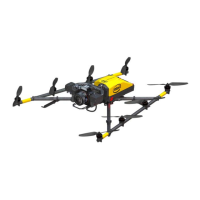USER MANUAL
INTEL® FALCON™ 8+ UAS
© 2017 Intel Corporation. All rights reserved 110
• Second warning: “Battery empty, land now” and a vibration of the CTR.
Text on Status Display: CP. BAT. EMPTY!
Text on tablet: Cockpit battery empty. Land now!The remaining
operating time of the CTR, shown as a percentage on the Status Display, is
flashing.
The audio warning is repeated every 10 seconds when the remaining operating
time < 1 minute.
3.10. IN-FLIGHT EMERGENCIES
Interruptions to the regular control behavior can be caused by interference sources
such as other transmitters near the UAV. They can disturb the video signal (5.8 GHz
frequency band), the data link connection (2.4 GHz frequency band) and/or the GNSS
module or other system electronics.
In some cases, malfunctions or electronic component failures can also lead to the
abnormal behavior of the UAV.
Possible emergencies, and recommended responses, are outlined below.
CAUTION: THE SYSTEM MUST ALWAYS BE LANDED BY THE PILOT!
THERE IS NO AUTO-LANDING IN CASE OF LOW OR EMPTY BATTERY.
Table 3.5: Operational Guidelines In Case Of Emergency
EVENT POSSIBLE ACTION
In GPS-Mode:
Position accuracy of the UAV is
low, and it starts drifting from
its current position.
Switch to Height-Mode and control the UAV in
Height-Mode.
With low GPS reception quality, the UAV might not
have automatically switched to Height-Mode yet,
and therefore drift from the current position prior
to being detected by the sensors is possible.
In GPS-Mode:
The UAV does not seem to
react to the control inputs of
the pilot while the data link is
not disturbed.
Switch to Height-Mode and control the UAV in
Height-Mode.
In GPS-Mode, the right control stick on the CTR
commands a specific speed. If the speed accuracy
is low because of low GPS reception quality (but
not yet automatically activated Height-Mode), the
reactions to control commands might be slow.

